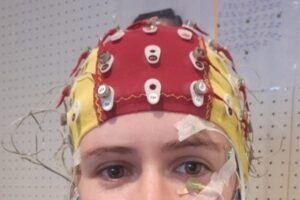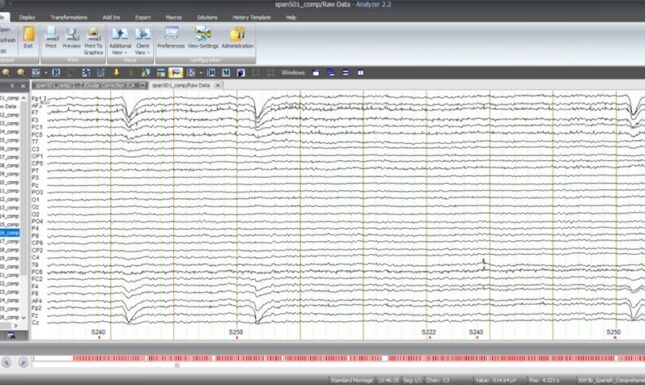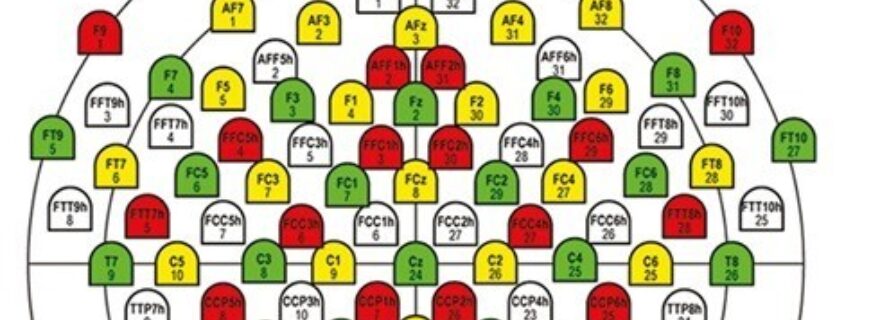The EEG Lab - where the magic happens
Sarah Von Grebmer Zu Wolfsthurn writes about the EEG lab at the Leiden University Centre for Linguistics.
Have you ever wondered what goes on in a 'lab' that does ‘human research on language’? If you have walked the halls of the Leiden University Lipsius building, you may have come across a somewhat suspicious advertisement sheet pinned to the poster boards stating something along the lines of “Are you interested in earning some money doing an experiment about language..?” Or perhaps you have actually ventured up to the first floor of the building and walked past the “Leiden University Linguistics Labs” – you know, the rooms down that lonely corridor with the flickering light? But what is it that actually goes on in these rooms? Let me explain.
Experimental labs
The Leiden University Centre for Linguistics (aka LUCL) has four experimental labs in total, each one specialised at looking at language processing from a slightly different perspective. The baby lab, for example, focuses on describing language processing and acquisition in tiny humans. In contrast, in the EEG lab we mostly do research on adult language processing. EEG stands for electroencephalography and it is a technique to measure electrical activity coming from brain cells directly from the scalp. And let me tell you, for someone who spends most of her time in the EEG lab, it can be a magical place (aside from the coffee machine and the incredible tea selection); this is where we uncover the secrets of language processing in the brain.

A participant in the EEG lab
So let me walk you through a typical experiment in the EEG lab. When you first come into the EEG lab as a participant in a language experiment, you will notice the fancy equipment that is meticulously organised on the shelves. Then, you will catch a glimpse of our slightly creepy-looking experimental booths. Fear not, everyone has made it out safely so far.
At the beginning of the experiment, you will be walked through the procedure by the experimenter (i.e., me). EEG equipment is very delicate and expensive and firstly involves the placement of a cap on the scalp. We have several sizes, so I would typically ask the participant to try on a few to see how the fit. To this cap, I connect so-called electrodes, which are the devices that measure the cellular activity directly from the scalp. I then attach the electrodes to a special device, which first transforms the analogue signal from the cellular activity into a digital signal which can be read by a PC. The PC, in turn, records this digital signal in the form of voltage amplitudes for the duration of the experiment. Ok, that's enough explaining of the procedure because now comes the best bit: the actual experiment.
Language tasks
One of my favourite moments is when everything has been connected and plugged in and the participants get to see their own brain waves on the screen. I explain to them that this is their brain at work trying to make to make sense of the world. After that I would then leave the participant to it – namely, I give them a task which involves language, such a picture-naming task, and record the corresponding brain braves. Depending on what we are investigating, these brain waves are a gateway to the inner workings of the brain. Not only can we tell if a participant has fallen asleep during the experiment (just kidding, almost never happens), but also if a participant finds it difficult or easy to name a picture. If you work with bilinguals like me, you may even be able to tell if the participant in question was struggling during the task because they could only think of the name of the object on the picture in their native language and not in their second or third language.
Before you think that we are actual mind-readers, a lot more work needs to go into processing the data we get from each participant for us to be able to conclude certain things. For example, whether the participant found it difficult or easy to do a certain task or come up with a specific word. But we do this after the experimental session (after we have sent them home with some funny-looking light marks on their forehead).
After the participant has gone, it is up to me to first clean all the equipment (yes, there is a lot of cleaning). But then I get to my absolute favourite bit: the moment where I roll up my sleeves and make those magnificent brain waves tell me absolutely everything...



